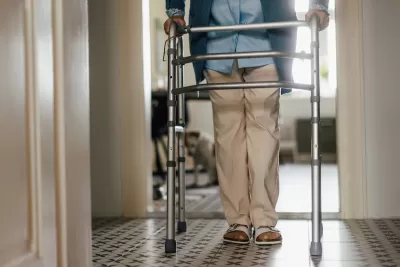Why developers should place more emphasis on building homes for aging residents and multigenerational living.

“Come 2034, there will be more adults age 65 and older than children, according to U.S. Census Bureau projections,” writes Lydia Lee in Builder Online. And according to an AARP survey, roughly 90 percent of those over 65 would prefer to stay in their current homes or communities as they age.
This has major implications for the building industry, Lee writes, as “very little of the current housing stock is designed for those with mobility challenges,” and no legal requirements like the Americans with Disabilities Act (ADA), which applies to public spaces and businesses, exists for homes.
According to a 2020 report from the U.S. Census Bureau, just one in 10 American homes are ‘aging-ready.’ “These aging-ready homes address the two core needs—single-floor living and bathroom accessibility—by providing a zero-step entry, a first-floor bedroom, and a full first-floor bathroom with at least one accessibility feature.”
A movement based around a new term, ‘visitability,’ mandated in some parts of the United States, including Pima County, Arizona and Vermont, seeks to address these issues by calling on builders to make all new homes more easily accessible with flush thresholds, ground-floor doorways with minimum clearance for wheelchairs, and ground-floor bathrooms large enough for wheelchairs. “Another key idea behind the term is that people should be able to visit others easily—that our social lives shouldn’t be impeded by mobility issues.”
Advocates say aging in place also applies to the broader community outside a person’s home. Some communities aimed at seniors ensure that shopping, social destinations, and other amenities are within walking distance, with lots of places to sit and shade trees to protect people from heat.
FULL STORY: Why Builders and Developers Should Be Constructing More Aging-Ready Homes

Alabama: Trump Terminates Settlements for Black Communities Harmed By Raw Sewage
Trump deemed the landmark civil rights agreement “illegal DEI and environmental justice policy.”

Planetizen Federal Action Tracker
A weekly monitor of how Trump’s orders and actions are impacting planners and planning in America.

The 120 Year Old Tiny Home Villages That Sheltered San Francisco’s Earthquake Refugees
More than a century ago, San Francisco mobilized to house thousands of residents displaced by the 1906 earthquake. Could their strategy offer a model for the present?

In Both Crashes and Crime, Public Transportation is Far Safer than Driving
Contrary to popular assumptions, public transportation has far lower crash and crime rates than automobile travel. For safer communities, improve and encourage transit travel.

Report: Zoning Reforms Should Complement Nashville’s Ambitious Transit Plan
Without reform, restrictive zoning codes will limit the impact of the city’s planned transit expansion and could exclude some of the residents who depend on transit the most.

Judge Orders Release of Frozen IRA, IIJA Funding
The decision is a victory for environmental groups who charged that freezing funds for critical infrastructure and disaster response programs caused “real and irreparable harm” to communities.
Urban Design for Planners 1: Software Tools
This six-course series explores essential urban design concepts using open source software and equips planners with the tools they need to participate fully in the urban design process.
Planning for Universal Design
Learn the tools for implementing Universal Design in planning regulations.
Clanton & Associates, Inc.
Jessamine County Fiscal Court
Institute for Housing and Urban Development Studies (IHS)
City of Grandview
Harvard GSD Executive Education
Toledo-Lucas County Plan Commissions
Salt Lake City
NYU Wagner Graduate School of Public Service


























